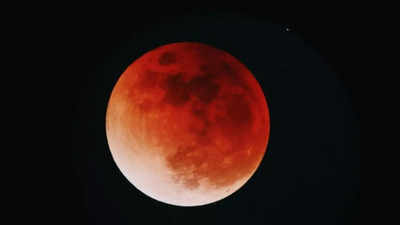Trending
Blood moon 2025: When, where, and how to watch the moon turning red during March's total lunar eclipse
A total lunar eclipse, known as a 'blood moon,' will occur on the night of March 13-14, 2025, making the moon appear a striking rusty-red color. North America, South America, and parts of Europe and Africa will have a great view of this rare cosmic event.
If the sky is clear, the pollution and clouds are at bay - we get to see the moon lighting the night sky with its bright silvery aura. Sometimes, the aura is more on the softer side of pale beige, giving the night sky a touch of milky white or rusty sepia-toned tenderness.
But nothing like an evening sky turning rusty-red color with the appearance of a ‘blood moon’.
What is a ‘blood moon’?
A ‘blood moon’ is a popular term for a total lunar eclipse when the moon appears red or ruddy brown in color.
On that night, the moon will appear to us here on Earth to turn a striking rusty-red color when it aligns with our planet and the sun. When this happens, the moon passes into Earth's shadow in a color-shifting process that lends it the nickname, ‘blood moon’.
The Moon's reddish hue occurs due to Rayleigh scattering, a phenomenon where Earth's atmosphere filters out shorter wavelengths of light, allowing red and orange tones to dominate. This is the same effect that creates the vibrant colors of sunrises and sunsets.
What happens during a blood moon?

A total lunar eclipse occurs when Earth is positioned directly between the sun and a full moon, causing the planet's darkest shadow, its umbra, to cover the lunar surface. The moon turns red because the only light reaching it is sunlight refracted through Earth's atmosphere, which filters out shorter wavelengths and leaves behind only long-wavelength, reddish hues. The physics is similar to what happens during sunrise and sunset. According to NASA, during a total lunar eclipse, the entire Moon falls within the darkest part of Earth’s shadow, called the umbra. When the Moon is within the umbra, it appears red-orange. Lunar eclipses are sometimes called “Blood Moons” because of this phenomenon.
During the total lunar eclipse, which will last about five hours, the full moon will travel through Earth's shadow and take on a striking reddish hue for 65 minutes. Unlike a total solar eclipse, which can be seen only from within a narrow path of totality, a total lunar eclipse is visible from anywhere on Earth's night side. Overnight on March 13-14, that will include all North American time zones, including Alaska and Hawaii. Observers in Western Europe will see the moon set while still eclipsed, while in Australia and New Zealand, it will rise already in totality. (Totality refers to the period when a celestial object is fully eclipsed, as seen from Earth.)
When will the blood moon occur?
According to Timeanddate.com, the lunar eclipse will happen in five stages between 11:57 p.m. and 6 a.m. EDT (03:57 to 10:00 UTC).
The first stage begins when the moon moves into Earth's fuzzy outer shadow, its penumbra, and loses its brightness. It then enters the umbra, and gradually turns reddish as the line of Earth's shadow moves across the moon.
According to NASA, if you live in the U.S., you can see the eclipse starting at about 11:57 p.m. EST when the penumbral phase begins as the moon enters the outer part of the shadow and begins to subtly dim.
At 1:09 a.m., a partial eclipse begins as the moon enters Earth's umbra and starts to darken. To the naked eye, the moon should look like a bite is being taken out of the lunar disk. The total lunar eclipse on March 13-14, 2025, will last just over six hours. It will begin with a penumbral eclipse — when the moon enters Earth's fuzzy outer shadow and loses brightness — from 11:57 p.m. to 1:09 a.m. EDT (03:57 to 05:09 UTC).
What you don’t want to miss, is the phase of totality when the entire lunar surface will appear reddish, becoming a true blood moon. Halfway through that 65-minute period, the event starts to run in reverse, with the moon gradually slipping out of Earth's umbra, then penumbra, before finally returning to its regular bright, white-gray color.
Totality occurs at 2:26 a.m. when the entire moon is under the umbra. This is when the reddish hues of the "blood moon" will be on display.
As the moon exits the umbra by about 3:31 a.m., the red color will fade and another bite-like display, this time on the other side of the moon, will appear. As NASA explains, the entire eclipse process is projected to end by 6 a.m. as the moon slowly exits the Earth's penumbra.
How do you watch the blood moon?

The upcoming total lunar eclipse, the first since November 2022, will also coincide with this year's full worm moon, the third and final full moon of the winter.
While lunar eclipses are relatively rare, when they do happen, they're visible to an entire half of Earth.
For this eclipse, the Western Hemisphere will be treated to the view, including all of North America. For those in the United States, that means all lower 48 states should have a view. The total lunar eclipse will also be visible over South America and western parts of Europe and Africa.
The blood moon will be best visible from Los Angeles, Mexico, Argentina, Spain, Portugal, and Egypt.
While you don't need any special equipment to observe the phenomenon, astronomers insist that the view will be even better with telescopes and binoculars. Regardless, a dark environment away from bright city lights makes for the best experience during the lunar eclipse.
A total lunar eclipse, or "blood moon," is a breathtaking celestial event where the moon takes on a deep red hue as it passes through Earth's shadow. On the night of March 13-14, 2025, skywatchers across North and South America will witness this rare sight. No special equipment is needed—just a clear, dark sky to enjoy this stunning natural spectacle.
The March 13-14, 2025, total lunar eclipse will be a spectacular sight, painting the moon a deep red for over an hour. Visible across North and South America, this rare event requires no special equipment—just a clear night sky to witness nature’s magic.
The upcoming blood moon is a reminder of the beauty and wonder of the universe. Whether you're an avid stargazer or just curious about celestial events, this total lunar eclipse is a sight worth witnessing. So, mark your calendars, find a good viewing spot, and enjoy this breathtaking display in the night sky.
End of Article
FOLLOW US ON SOCIAL MEDIA
Visual Stories
Tired of too many ads?









